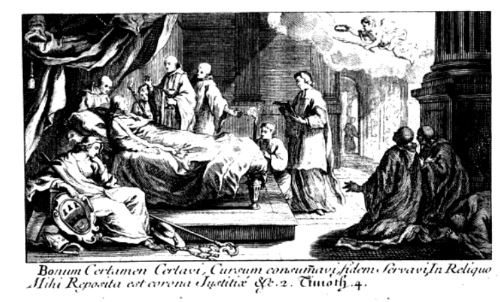 I came across an old life of the Jansenist Bishop Soanen of Senez, dated 1902, which piqued my curiosity, since it was subtitled "his retraction, his death, his skull". The story of the skull appears on pg. 60, and is taken from a Lyon newspaper article of February 1890. We learn that a skull, said to be that of Soanen, had been inherited by a young man who subsequently sold it for next to nothing to an antiques dealer in the Quartier des Terreaux. He in turn sold it for 1,000 francs to a "Jansenist lady", who apparently already owned the bishop's jawbone. Sieur B. the agent who had secured the transaction, touting around the skull in a silk lined casket, now demanded 500 francs in commission and threatened legal action.
I came across an old life of the Jansenist Bishop Soanen of Senez, dated 1902, which piqued my curiosity, since it was subtitled "his retraction, his death, his skull". The story of the skull appears on pg. 60, and is taken from a Lyon newspaper article of February 1890. We learn that a skull, said to be that of Soanen, had been inherited by a young man who subsequently sold it for next to nothing to an antiques dealer in the Quartier des Terreaux. He in turn sold it for 1,000 francs to a "Jansenist lady", who apparently already owned the bishop's jawbone. Sieur B. the agent who had secured the transaction, touting around the skull in a silk lined casket, now demanded 500 francs in commission and threatened legal action. The case was eventually settled out of court.
As the writer notes, the incident proved that Jansenist piety and veneration for the appellant cause was live and well among the anticoncordataires of 19th-century Lyon, who were few in number, but represented several influential and wealthy families.
I was motivated to find out more about the bishop and his relics.
The funeral of Bishop Soanen
Jean Soanen, former Bishop of Senez, died peacefully in exile at the Abbey of La Chaise-Dieu in the Haute-Loire on Christmas Day 1740. He was a frail old man, just short of 94 years old.
 |
| Jean Soanez, Bishop of Senez, Painting by Jean Raoux, c.1723 |
At None on the day of St. John, the body was taken to a domestic chapel in the lower part of the East Wing of the Abbey complex, commonly called the College Chapel. The monks had prepared a raised bier and a great crowd of people made the journey to pay their last respects despite the winter weather. The corpse, which retained its flexibility, was exposed in the chapel until the next day, the Feast of the Holy Innocents. At ten in the morning it was carried into the church and a Solemn Mass celebrated, before it was returned to the chapel for burial. The Bishop's chaplain, whose duty it was to cover his face with a cloth, knelt at the feet of the coffin and delivered a brief eulogy. Choked with emotion, he kissed the dead man's hands - "chained for the truth; but always free in its defence". Several religious and also some laymen prostrated themselves. The body was sealed in a lead coffin and buried within a tomb cut deep into the bedrock, near the sanctuary of the chapel, the resting place of two former bishops of Puy. The existing stone was replaced but the grave remained unmarked, since it had been forbidden to allow Soanen an epitaph (p.64-5). An inscription was added some time later.
 |
| The Bishop's deathbed, from La vie et les lettres de Messire Jean Soanen, évêque de Senez (1750) |
 |
| Fragments from the tombstone of Bishop Soanen incorporated into a fireplace http://www.abbaye-chaise-dieu.com/L-architecture-mauriste-a-La,106.html?lang=en |
As to the skull, our book tells us that the purchaser in 1890, "une vieille demoiselle de Sainte-Foy-lès-Lyon", had died in her turn and the relic was now in the possession of one of her nephews. What happened to it next, I have been unable to discover!
References
Elie Jaloustre, Jean Soanen, évêque de Senez, à l'abbaye de la Chaise-Dieu : sa rétractation, sa mort, son crâne (1902), p.60ff
https://archive.org/stream/jeansoanenvq00jalo#page/60/mode/2up
La vie et les lettres de Messire Jean Soanen, évêque de Senez (1750), p.144ff.
https://books.google.co.uk/books?id=QA-7eTiJnhYC&pg=PA144#v=onepage&q&f=false
Odon Hurel, "L’abbaye de La Chaise-Dieu et ses relations avec les jansénistes" Lecture 2011) Abbaye de la Chaise-Dieu website:
http://www.abbaye-chaise-dieu.com/L-abbaye-de-La-Chaise-Dieu-et-ses.html
The Abbey of La Chaise Dieu, which has Medieval danse macabre wall paintings and 16th-century Flemish tapisteries, is now the subject of a major renovation project. See
http://www.projet-chaise-dieu.fr/


No comments:
Post a Comment